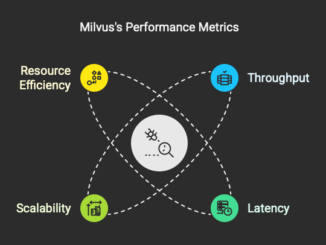Milvus Architecture
Milvus is a purpose-built vector database optimized for similarity search and AI workloads. Its architecture is distinct from traditional RDBMS like PostgreSQL and MySQL, as it is designed to handle high-dimensional vector data (e.g., embeddings) rather than traditional structured data. Below is an overview of the Milvus architecture and how it differs from traditional relational database systems.
1. Milvus Architecture Overview
Core Components:
- Query Node • Handles search queries and retrieves relevant vector data. • Uses vector search algorithms like IVF_FLAT, HNSW, or ANNOY for similarity search. • Performs distributed query processing in a cluster setup.
- Data Node • Handles data ingestion and storage. • Writes vector and metadata to persistent storage. • Manages data replication and erasure coding for fault tolerance.
- Index Node • Builds and manages vector indices (e.g., IVF, HNSW). • Offloads compute-intensive indexing tasks from the query and data nodes.
- Root Coordinator • Serves as the central control plane for the cluster. • Manages metadata, task scheduling, and node coordination. • Ensures data consistency across distributed nodes.
- Proxy • Acts as the entry point for client applications. • Routes requests to appropriate query or data nodes. • Performs authentication and API handling.
- Storage Layer • Supports various storage backends like local SSDs, HDFS, or cloud object storage (e.g., S3, GCS). • Handles the separation of hot (frequently accessed) and cold (archived) data for optimal performance.
- Cache Layer • Provides in-memory caching for frequently accessed data and indices. • Reduces query latency for read-heavy workloads.
- Monitoring and Logging • Integrates with Prometheus and Grafana for metrics and visualizations. • Provides detailed logs for troubleshooting and performance tuning.
2. Differences from Traditional RDBMS
| Aspect | Milvus | Traditional RDBMS (PostgreSQL/MySQL) |
|---|---|---|
| Data Model | Vector-based: Focuses on storing and querying high-dimensional vectors for similarity search. | Relational: Uses tables with rows and columns for structured data. |
| Query Types | Nearest neighbor search, vector similarity queries. | SQL-based CRUD operations, joins, aggregations, and analytical queries. |
| Indexing | Vector-specific indices like IVF_FLAT, HNSW, ANNOY for fast similarity search. | B-tree, hash, or GIN indices for efficient querying of relational data. |
| Workload Type | Optimized for AI/ML workloads (e.g., recommendation systems, image search, NLP). | Transactional and analytical workloads, including OLTP and OLAP. |
| Scaling | Designed for horizontal scaling with distributed nodes for query, data, and indexing. | Supports vertical scaling and limited sharding. |
3. Unique Features of Milvus
- Vectorized Query Processing: Optimized for nearest neighbor searches and similarity computations.
- GPU Acceleration: Supports GPU-based indexing and query execution for high-speed vector computations.
- Distributed Architecture: Built from the ground up for distributed scalability, handling petabyte-scale vector data.
- Integration with AI Workflows: Seamlessly works with embeddings generated by AI models.
4. Use Case Comparison
| Use Case | Milvus | PostgreSQL/MySQL |
|---|---|---|
| Image or Video Search | Efficient vector similarity search | Not suitable; requires additional frameworks |
| Recommender Systems | High-speed similarity search in vector space | Limited; needs custom algorithms |
| Relational Data Management | Not ideal; lacks SQL support | Well-suited with normalized table designs |
5. When to Choose Milvus vs. RDBMS
Milvus complements traditional RDBMS by addressing AI/ML and vector-based workloads. While PostgreSQL and MySQL excel at structured data management and transactional processing, Milvus focuses on the unique demands of similarity search and large-scale AI-driven applications.
| Requirement | Choose Milvus | Choose PostgreSQL/MySQL |
|---|---|---|
| High-dimensional vector search | Most suitable - optimized for vector operations | Limited capabilities, requires extensions |
| AI/ML model integration | Native support for embeddings and similarity search | Requires additional frameworks |
| Relational data handling | Limited SQL support | Excellent with complex relationships |
| Query performance | Optimized for vector similarity queries | Optimized for structured data queries |
| Scalability approach | Built-in horizontal scaling | Primarily vertical scaling |
6. Conclusion
Understanding the architectural differences between Milvus and traditional RDBMS is crucial for making informed technology choices. While Milvus excels in vector similarity search and AI-driven applications, traditional RDBMS remain essential for structured data management. The key is recognizing that these systems serve different purposes and can coexist in modern data architectures.
Organizations should evaluate their specific needs - whether they require efficient vector search capabilities for AI applications (Milvus) or robust relational data management (RDBMS). In many cases, a hybrid approach might be optimal, leveraging both systems' strengths to build comprehensive data solutions that can handle both traditional and AI-driven workloads effectively.
© 2024 MinervaDB Inc. All rights reserved.
Milvus® is a registered trademark of Milvus. All other trademarks, service marks, and company names are the property of their respective owners.
This document is provided for informational purposes only. No part of this document may be reproduced or transmitted in any form or by any means, electronic or mechanical, for any purpose, without written permission from MinervaDB Inc.


